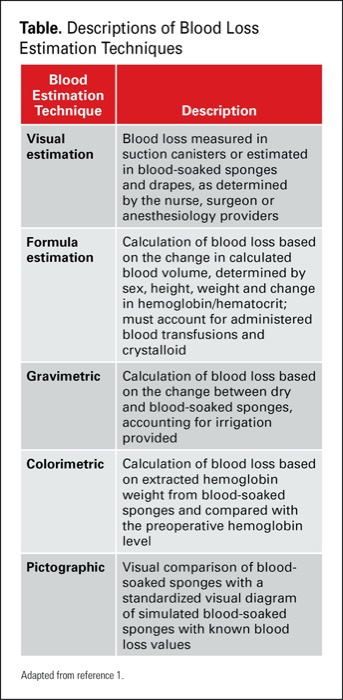Ziekenhuis Oost-Limburg (ZOL) Genk, Belgium; and
NYSORA (New York School of Regional Anesthesia)
Anesthesiologists and surgeons frequently encounter intraoperative hemorrhage during major surgery. The accuracy of estimated blood loss (EBL) is important in clinical decision making and crucial as an instrument in surgical outcomes research. For instance, EBL can guide perioperative transfusion practice and serve as a key predictor of short-term perioperative risks and long-term oncological outcomes.
Methods for measuring blood loss, however, are often complex, vague or difficult to implement in clinical practice. Since there is no gold standard for EBL during the intraoperative period, methods may differ across institutions, disciplines and among individual health care providers.
In a recent review of the literature, Tran et al1 evaluated the different methods of determining EBL during noncardiac major surgery. The authors systematically reviewed available studies, until 2020, and categorized them into three groups for comparison:
- visual estimation versus formula estimation;
- visual estimation versus other; and
- formula estimation versus other.
For each of these comparisons, tendencies for higher or lower EBL values, consistency of findings, pooled mean differences, standard deviations and confidence intervals were studied.
Eventually, the authors included 26 studies with over 3,000 patients in their analysis. Visual estimation of blood loss appeared to be the most frequently used technique for EBL. However, visual estimation techniques tended to provide lower EBL values than formula-based estimation or other techniques. When accounting for mean blood loss, similar case-to-case variation existed for all estimation techniques.
Based on the systematic review of the literature and meta-analysis, Tran et al suggested that a formula-based technique of EBL may be the most accurate and reproducible method for intraoperative blood loss evaluation.
| Table. Descriptions of Blood Loss Estimation Techniques | |
| Blood Estimation Technique | Description |
|---|---|
| Visual estimation | Blood loss measured in suction canisters or estimated in blood-soaked sponges and drapes, as determined by the nurse, surgeon or anesthesiology providers |
| Formula estimation | Calculation of blood loss based on the change in calculated blood volume, determined by sex, height, weight and change in hemoglobin/hematocrit; must account for administered blood transfusions and crystalloid |
| Gravimetric | Calculation of blood loss based on the change between dry and blood-soaked sponges, accounting for irrigation provided |
| Colorimetric | Calculation of blood loss based on extracted hemoglobin weight from blood-soaked sponges and compared with the preoperative hemoglobin level |
| Pictographic | Visual comparison of blood-soaked sponges with a standardized visual diagram of simulated blood-soaked sponges with known blood loss values |
| Adapted from reference 1. | |
The Table lists common intraoperative blood loss estimation techniques and their description. From these techniques, subjective visual quantification is the most commonly used approach. Other methods include formula-based estimation incorporating changes in hemoglobin and hematocrit (Figure), and gravimetric-based estimation incorporating changes in the dry and wet weight of surgical sponges.
References
- Tran A, Heuser J, Ramsay T, et al, Techniques for blood loss estimation in major non-cardiac surgery: a systematic review and meta-analysis. Can J Anesth. 2020;68(2):245-255.
- American Society of Anesthesiologists Task Force on Perioperative Blood Management. Practice guidelines for perioperative blood management: an updated report by the American Society of Anesthesiologists Task Force on Perioperative Blood Management. Anesthesiology. 2015;122(2):241-275.
- Ross SW, Christmas AB, Fischer PE, et al. Defining dogma: quantifying crystalloid hemodilution in a prospective randomized control trial with blood donation as a model for hemorrhage. J Am Coll Surg. 2018;227(3):321-331.
- Nadler SB, Hidalgo JH, Bloch T. Prediction of blood volume in normal human adults. Surgery. 1962;51(2):224-232.
Originally published by our sister publication, Anesthesiology News



